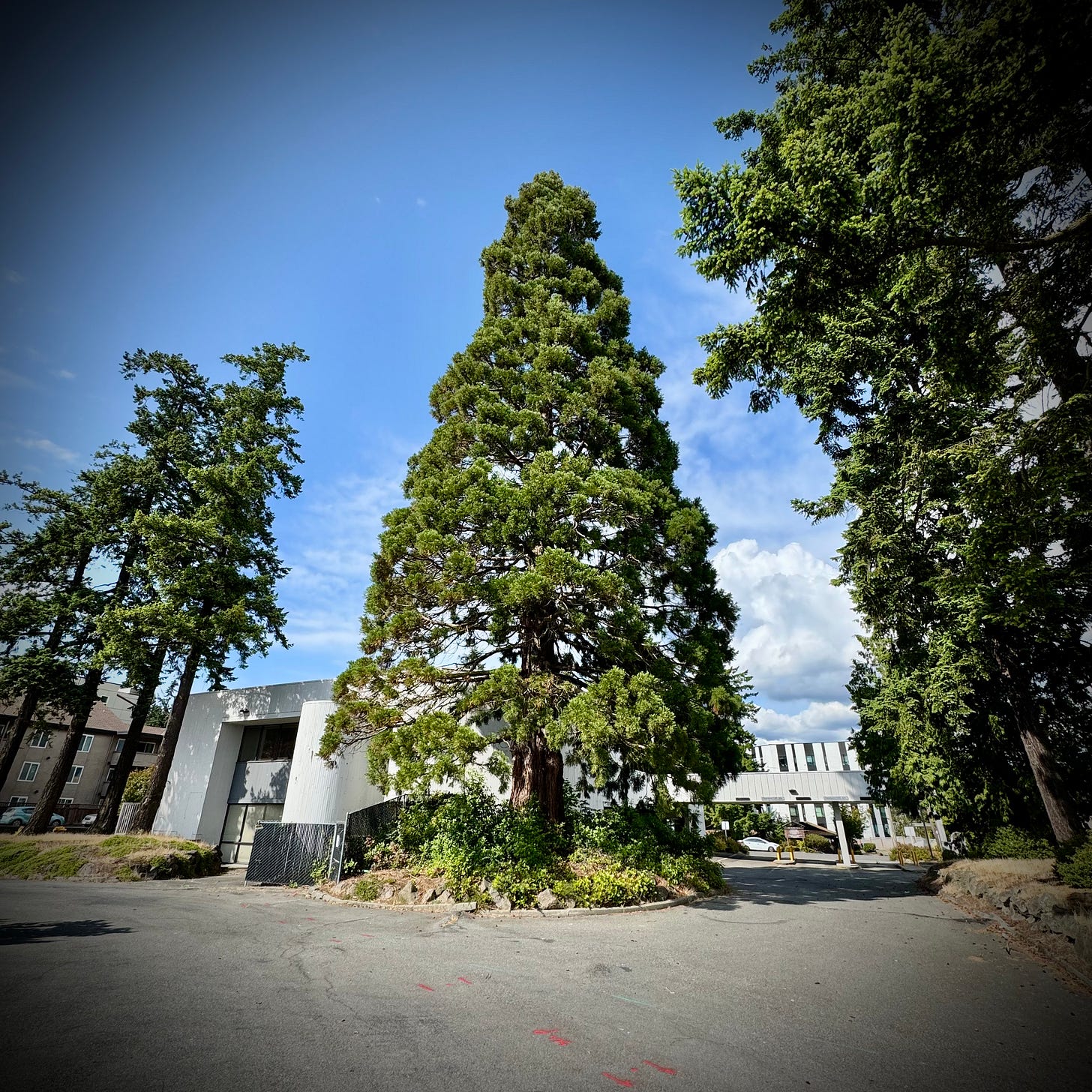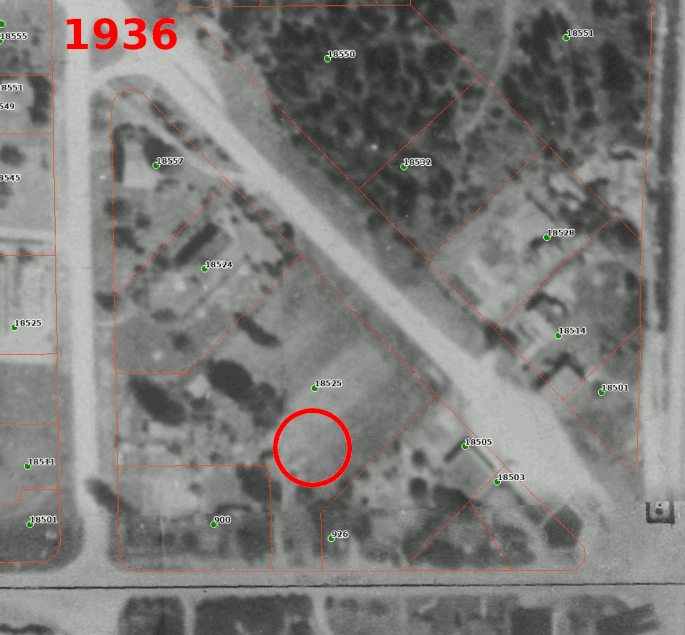Shoreline blocks removal of the Firlands giant sequoia; again
Shoreline again blocked the removal of the Firlands giant sequoia for another six months despite objections from the owner who is trying to sell the property.
At the July 14 meeting, the Shoreline city council voted unanimously to renew a six-month, emergency ordinance blocking the removal of exceptionally girthsome trees in the Town Center (TC3 and TC4 zones). The council previously blocked the removal of the Firlands giant sequoia earlier this year despite objections from the property’s owner.

The Town Center abuts Aurora and includes City Hall, the office building the city recently purchased, and the storage court north of City Hall the city purchased in 2020. It also includes the block of Firlands Way just north of 185th.
The emergency rule defines “exceptional” trees as trees with a diameter at breast height (DBH) greater than sixty inches. There aren’t a lot of very big trees in the Town Center. There is a big Douglas Fir on the southwest corner of Stone Way N and N 180th St that might be larger than 60” DBH but everyone agrees the ordinance is targetting one tree: the Giant Sequoia at 18525 Firlands Way, which stands in the middle of the 1.126-acre parcel where the old Bank of America used to be. According to Save Shoreline Trees, the Firlands giant sequoia measured 72.8” DBH in 2023.
Councilmember Annette Ademasu co-sponsored the emergency ordinance and said, “Here we are today in Shoreline trying to protect these elder trees. There aren’t too many of them. We know there's one in the TC3 and 4 zone. We're not sure how many there are. Are there five others in the city? We're not really sure. So I would just say I would like this one protected.”
Robert McCaughan, whose family has owned the Firlands property for generations, told the council earlier this year that the tree was required to be kept as landscaping when the bank was built in 1978.
A photo from the Shoreline Historical Museum’s website taken during the bank’s construction in 1978 appears to show the young sequoia. And an aerial photo on King County’s website from 1936 shows that the site was a vacant lot. Together, that evidence would place the tree’s age at somewhere in the range of 50 to 90 years old.

It is not possible to definitively measure the age of a tree based solely on its height or the width of its trunk, but giant sequoias are (as their name suggests) legendary for growing fast, living long, and getting very, very big. The width of a giant sequoia trunk grows faster than other tree species, and its girth can increase by one to two inches every year.
Robert McCaughan, the property owner, said the tree causes property damage is a hazard. The tree is now damaging the pavement of the parking lot, and its copious needles clog the stormwater system.
McCaughan said he had offered to sell the property to the city, but the city declined. Instead of purchasing the property and preserving the tree, the city has banned its removal. The property is still for sale.
Councilmember Keith Scully acknowledged the ordinance was targeted at the single tree and said, “But one tree in this zone that is such a centerpiece for me, that's not even a close call because we've got to make our cities dense. We've also got to make them livable. Partly so that they are livable and partly so people want to live here.” He expressed support for permanent protections, “In the long term, we probably will be permanently protecting those very few remaining trees that are that big.”
The temporary restrictions expire in six months, and the city must hold public hearings on the rules.
In an effort to spruce up its tree code, over the last year, the city council has changed tree removal fees three times, held public hearings, and has now banned the removal of the Firlands giant sequoia twice. The city hired a consultant to undertake a holistic update to Shoreline’s tree regulations because they are confusing and inconsistent. Shoreline hired a consultant and will convene a Community Advisory Group (CAG) comprised of 10-12 members. Recruitment will begin in summer 2025 via an online application. The CAG will hold up to seven meetings starting September 2025 for 7-8 months, informing the draft code. The new Tree Code is anticipated for adoption by spring 2026.


I'm a city resident, and retired arborist of 50 years. I do like that tree, and agree that it deserves to stay. That said, I'd guess the tree to be less than 80 years old, based on my story below. (Though, based on its location, it isn't growing as fast as it would in a better place.
I've been following this story, on your blog, and perhaps in Shoreline news.
15 years ago now, my company (Barnett Tree Care) removed what was certainly the largest tree in Shoreline, and likely anywhere north of Seattle and west of the Cascades, east of the Olympics, and north to Canada. It was another sequoia giganteum,naturally. It had been planted in 1912, iirc. It was in The Highlands, privately owned, but close to a mansion that was more valuable than the tree, which had planted much too close to the adjoining garage. At the closet corner of the house, some windows and doors weren't working smoothly. The owners loved the tree, but it was the wrong species for its location. At that same time, at the carriage house not 125' away, at what is now a separate owned property, grows its sister. That tree is well located but near some other firs, so its canopy isn't quite as wide or dense. I hope it lasts for another century.
This beaut was over 8' dbh, and 10' at ground level. It was ~158' tall. It took over two days for a crew of six the first day, and 3 the next, to remove it. Required a 90 ton crane. The wood filled two log truck loads, with the bunks set as short as possible. We created some 70 yards of chips, over four loads, which the customer loved where we dumped them.
Here's a link to too many images of the tree and job. https://flic.kr/s/aHsjqT7iU4
I have visited, measured and photographed the largest sequoia in Wa, which is in Ridgefield. IIRC, it is now about 11' dbh. But there is a monster in Schmitz Park (W. Seattle) that I haven't seen, and another behemoth south of Madison Park, a couple blocks from Lk. Wa. It is very healthy but also is well over 10' dbh by now.
Let's hope it never has to be removed, as it would take a huge crew of the bestarborists in town 2 weeks to a month to bring down. And that's a fact, Jack.